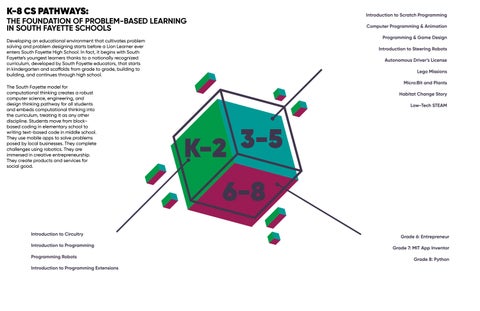LEADING THE WAY THROUGH
PROBLEM-BASED LEARNING
IN SOUTH FAYETTE TOWNSHIP SCHOOLS

PROVEN FOUNDATIONS & REAL IMPACT

Heralded as a leader in innovation, the South Fayette Township School District, located outside of Pittsburgh, Pennsylvania, is embarking on an ambitious new chapter – one that embodies the core tenets that have earned the District regional and national distinctions and embraces collaborative learning experiences that lead to purposeful change in the community.
In 2021, the Pittsburgh Business Times named the South Fayette Township School District western Pennsylvania’s “District of the Decade.” South Fayette topped the list of more than 100 public school districts across seven counties. The rankings resulted from a careful analysis of more than 300 data points from state standardized tests from 2010-2019. The publication highlighted the District’s focus on computational thinking and literacy across all grade-levels.


“The honor of being named the ‘District of the Decade’ in a region of the country with, quite possibly, the greatest share of exemplary schools was a testament to the efforts of the entire South Fayette Township School District community,” said Superintendent Dr. Michelle Miller. “However, we could not depend on the work that made us stand out last decade to excel in the next. The educational environment of today looks remarkably different than it did just several years ago. We must be ready to transform if we are expected to lead.”
The District’s transformative work places future-ready Lion Learners at the heart of every decision, program, and initiative with concentrated cultural foundations of being future-focused, student-centered, and innovationdriven. Each of the district’s five strategic goals radiate from at least one of those three core values.
At the center of South Fayette’s vertically aligned and nationally recognized K-8 computer science pathway is problem solving. Beginning in elementary school, Lion Learners are encouraged to think logically, critically, algorithmically, and recursively. The South Fayette CS Pathway is rooted in research from the University of Pittsburgh and Clemson University to foster equitable participation among girls and students of color, leading to its successful replication and implementation by schools throughout the region and country.
Because South Fayette classrooms cultivate curiosity and prioritize problem-designing and problem-solving across grade-levels, Lion Learners enter high school prepared for relevant, difference-making opportunities in multiple disciplines. Through strategic partnerships with national businesses, leading universities, and socially-conscious groups and organizations, South Fayette students effect change in their communities and position themselves for a lifetime of impact.
TIMELINE OF INNOVATION

Growing a K-12 culture of innovation is not and cannot be the work of one or a few. Nor will it sprout immediately. Rather, it must be the result of careful, continuous, and collective efforts.
In South Fayette, the District created systems for embedding innovation in the school day. Each of the district’s four schools has a dedicated makerspace or prototype lab. These spaces are the creative hubs in each school where all learners have access to the technology, resources, and support to envision the next advancement that can transform our world, and their futures.
To support this work, the South Fayette Township School District developed incubator programs where new opportunities may start small but are given the attention needed to sprout into far-reaching curricular programs. Reimagined existing teaching positions and new STEAM teacher positions with the backing of the District’s Board of School Directors and community support the work of innovation. Meanwhile, district leaders have worked to create the profile of a Lion Learner, with the embedded knowledge, skills, and priorities essential to foster a culture of innovation.
The video to the right presents South Fayette’s Timeline of Innovation.

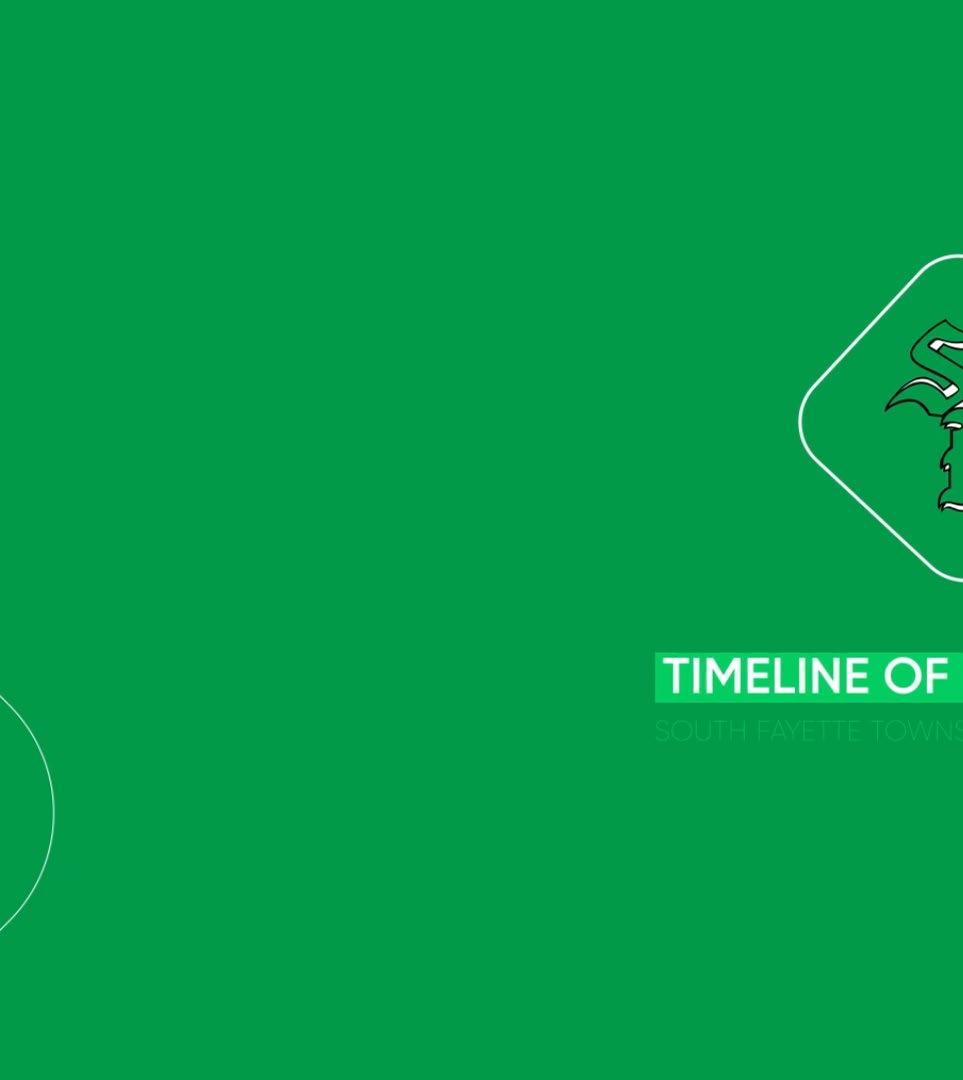

PATHWAYS: THE FOUNDATION OF PROBLEM-BASED LEARNING IN SOUTH FAYETTE SCHOOLS
Developing an educational environment that cultivates problem solving and problem designing starts before a Lion Learner ever enters South Fayette High School. In fact, it begins with South Fayette’s youngest learners thanks to a nationally recognized curriculum, developed by South Fayette educators, that starts in kindergarten and scaffolds from grade to grade, building to building, and continues through high school.
The South Fayette model for computational thinking creates a robust computer science, engineering, and design thinking pathway for all students and embeds computational thinking into the curriculum, treating it as any other discipline. Students move from blockbased coding in elementary school to writing text-based code in middle school. They use mobile apps to solve problems posed by local businesses. They complete challenges using robotics. They are immersed in creative entrepreneurship. They create products and services for social good.
6-8
Introduction to Circuitry
Introduction to Programming
Programming Robots
Introduction to Programming Extensions
Introduction to Scratch Programming
Computer Programming & Animation
Programming & Game Design
Introduction to Steering Robots
Autonomous Driver’s License
Lego Missions
Micro:Bit and Plants
Habitat Change Story
Low-Tech STEAM
Grade 6: Entrepreneur
Grade 7: MIT App Inventor
Grade 8: Python
K-2
Introduction to Programming
Students develop an understanding of a computer programmer’s role in making our technology work as we expect it to
Students practice “programming” each other around the classroom to learn how to break large tasks into simple instruction
Students create and program their own animations and games using Scratch Junior, a blockbased programming tool
Students apply their knowledge to create their own characters, stories, personal projects, and games
Programming Robots
Students utilize their programming knowledge on external devices: robots
Students program BeeBots to follow lines on the floor using directional code
Students practice writing code for their BeeBot
Students build Lego robots, add motors and sensors, and use code to automate their actions
Students learn Blockly, another block-based code, to program Dash, a robot that can move, talk, draw, throw balls, pick things up, and more
Introduction to Programming Extensions
Students are introduced to the Micro:Bit, a tiny, hand-held computer
Students program Micro:Bit and explore the device using simple coding challenges
Introduction to Circuitry
Students gain insight into how our technology devices work
Students make simple circuits using homemade Play-Doh, batteries, and LED lights
Students take apart an electronic toy and pull out the circuitry components to learn about the hardware
Students create their own circuit board and turn it into a game
Students combine hardware with software to build and play their own circuit instrument
Students develop a wearable programmed armband that they can use to display information
Students utilize the Micro:Bit for data collection and build a voting machine to gather information from classmates
3-5
Computer Programming & Animation
Students express themselves through programming in Scratch
Students become familiar with sound, looks, and motion blocks as they create projects related to music, art, and animation
Students continue to develop debugging strategies to fix common errors
Students combine music, art, and animation to create an interactive greeting card
Students learn the processes needed to program a story
Students practice writing procedures using the Make a Block feature, where multiple step sequences can be reduced to a single command
Students program a story of their own
Programming & Game Design
Students create a series of starter game projects to learn the basics of video game design, culminating in the creation of a full game
Students explore game mechanics through unplugged and connected activities
Students create a maze game, a pong game, and a scrolling game and use a paint editor to draw backgrounds
Students complete a series of short challenges designed to explore various ways to enhance their games
Students build upon one of their three starter games to complete a full game that keeps score, changes levels, and provides feedback to the player
Introduction to Scratch Programming
Students learn the basics of block based programming
Students create their first project and learn how to share their projects to a studio and provide meaningful feedback to others
Students develop strategies for testing and debugging problems within a Scratch program
Students play one another’s games in an arcade setting and then provide critiques so improvements to their games can be made
Introduction to Steering Robots
Students are introduced to steering and driving Mindstorm Robots
Students understand automation through sequences then learn about all the components of their robot
Students move into understanding controls and variables
Students work through a step-by-step activity to identify what happens when one of their variables is changed in their program
Students design their own unique maze and program their robot to travel in directions through the maze
Autonomous Driver’s License
Students apply their basic understanding of how to steer the Mindstorm Robot to earn their autonomous driver’s license
Students pass a car inspection and driver’s education course before moving into using sensors and motors for reversing and snow removal
Students learn how to steer their robot, use touch and ultrasonic sensor, and the medium motor
Lego Missions
Students work to solve first LEGO League “Into Orbit” space challenges
Students engineer their robot to autonomously solve a mission, selecting the appropriate sensors, motors, and Lego pieces
Students use coding to ask questions and solve problems that would occur in space
Micro:Bit and Plants
Students program a Micro:Bit to help solve a problem with planting
Students learn how to use a Micro:Bit by creating a rock, paper, scissors game
Students develop a soil moisture detector to determine whether a plant needs to be watered
Students create an automatic plant watering system
Habitat Change Story
Students learn how to program and use Hummingbird robotics kits to create a scene from the story “Follow the Drinking Gourd”
Students animate their habitat scene showing changes from man-made or natural occurrences over time and how to fix it
Students explain ways they can help prevent or encourage the change in the future
Low-Tech STEAM
Students explore low-tech, high-impact STEAM activities using common household and classroom items
Students develop their problem-solving mindset using stories or games as inspiration
Sixth Grade: Entrepreneur
Students are challenged to create their own business and invention
Communication: Students are connected to real-world situations and develop the collaboration skills necessary to market a new product
Engineering Design Process: Students create their own version of the Engineering Design Process which will be used to solve a problem
Market Opportunities: Students develop new ideas as they collaborate in groups to brainstorm new products based on their research
Problem Statements: Students create an authentic problem statement to address an issue they are working to solve
Rapid Prototyping: Students utilize recycled materials found around the school to create a rapid prototype of their invention
Company Branding: Students establish a company identity and understand the power of design in businesses
Stakeholder Mapping: Students create a stakeholder map and a crowdfunding campaign
Final Project: Students utilize their rapid prototype and designs to create a final product
Packaging: Students develop a professional looking package for their invention
Business Plan/Patent: Students learn how to safely bring their product to market through a sound business plan and patent for their invention
Seventh Grade: MIT App Inventor
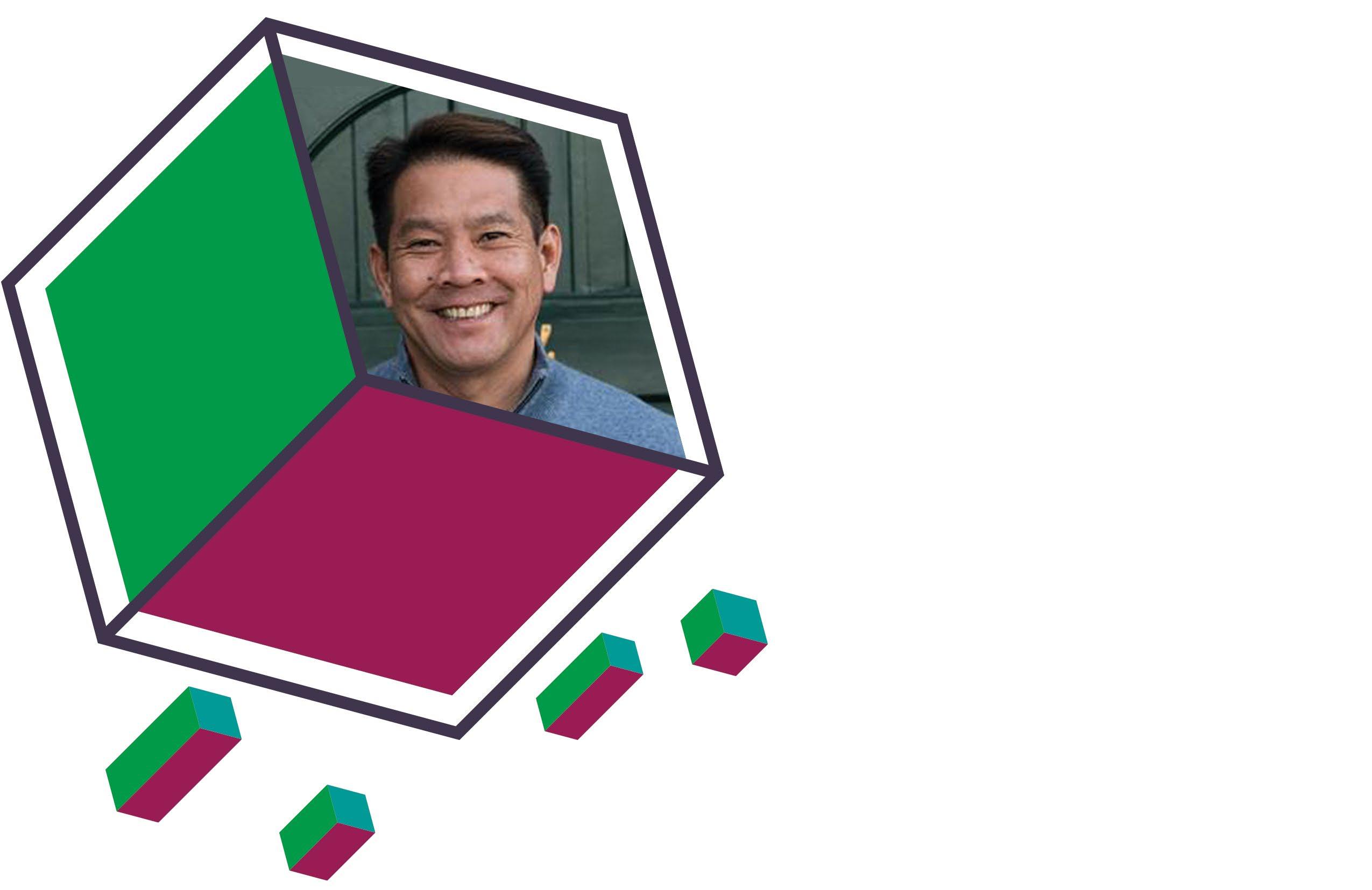
Students are immersed in the world of app development and create applications for Android devices
App Inventor Basics: Students work through a series of tutorials to learn how to use the components and blocks to create their first app
Beginner Practice: Students advance their skills using canvas elements, arrangements, variables, and procedures
Advanced Applications: Students chose one or more advanced apps to complete
Community App: Students use their acquired knowledge to develop an original app to help their community or a person in their community
Eighth Grade: Python
Students are introduced to python programming and will learn basic functions and concepts that programmers use consistently
Students discover how Python programming is being used in major companies around the world
Students learn the Python syntax of a print function and its importance in coding
Students are taught how to create comments in Python and work towards creating variables and testing their variables in a program
Students begin to test, predict, and explore more complex Python code
Students are introduced to Finch robots and learn the basic commands to get the robot to move forward, backward, and turn, as well as using the robot LED light
Students complete various challenges through the use of Finch robots and turtle programming that will test their understanding of previously taught concepts
In 2015 we were able to bring a team of educators from Cajon Valley to experience Remake Learning in Pittsburgh as part of the League of Innovative Schools’ bi-annual convening with Digital Promise.
One of the highlights of our visit was the South Fayette Township School District, where we saw some of the most innovative work around CS Pathways, STEAM, and personalized learning.
The South Fayette team is leading important and trailblazing work!
Dr. David Miyashiro Superintendent, Cajon Valley Union School District
The K-8 CS Pathways created by South Fayette educators immerse all Lion Learners in the skills needed for authentic computational thinking. Students develop a problem thought process and think abstractly. A big problem can be solved by breaking it down into smaller parts. That is when patterns emerge and future problems become easier to solve.
As Lion Learners transition to high school, they rely on the skills they acquired through the K-8 CS Pathways. These problem-solvers and problem-designers now have voice and choice into how they apply their computational thinking knowledge.
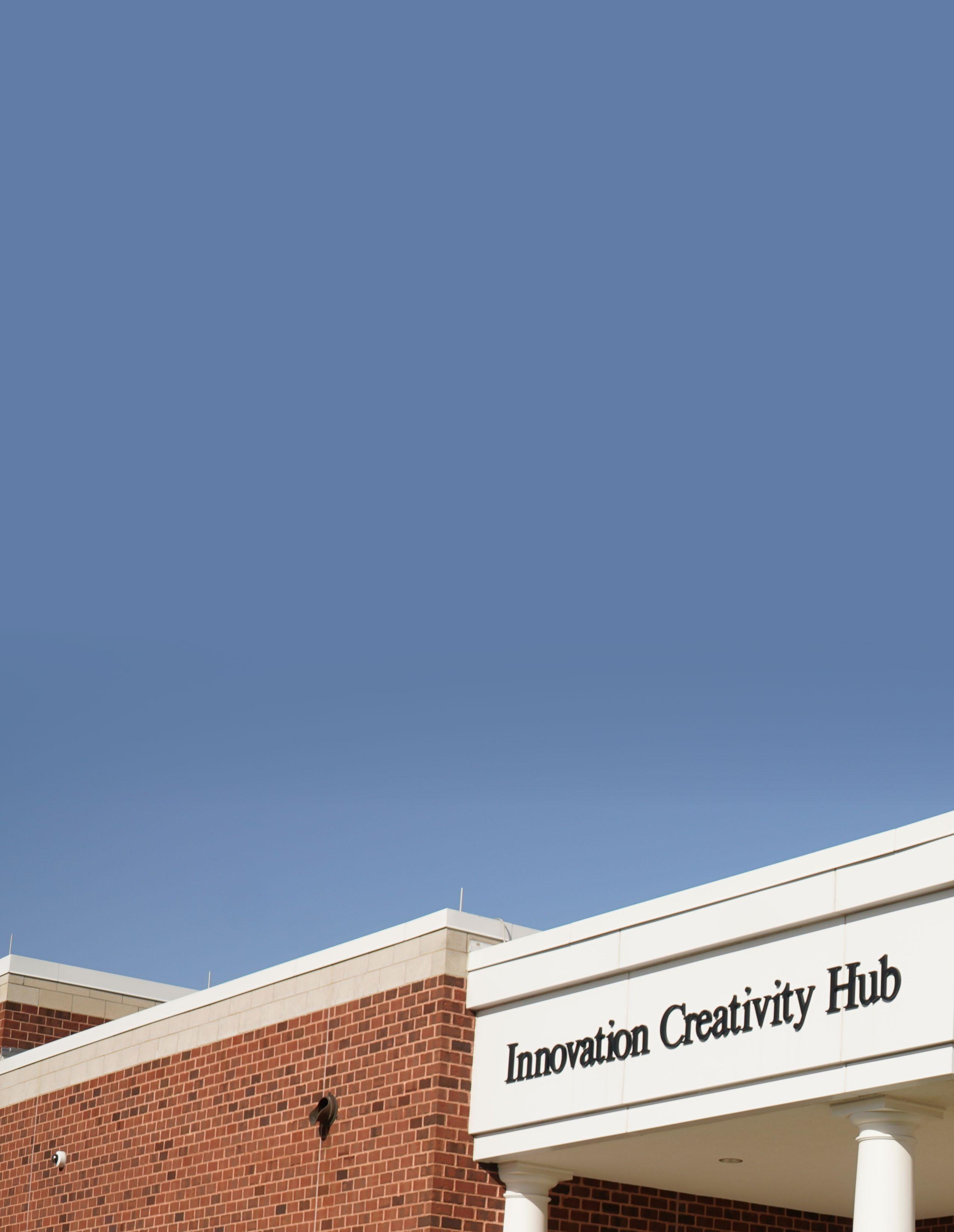
In every classroom, in every subject area, in every department, South Fayette High School prioritizes problem-based learning. Engaged Lion Learners do not just learn concepts and principles; they put them into practice. The problems they solve are not created in classrooms; they come from global industry professionals, leading universities, and premier social organizations and groups. The work South Fayette students create does not sit on an educator’s desk, nor is it stored in the cloud; it is being implemented and utilized in professional spaces.
If the South Fayette K-8 CS Pathways are the bridge to rigorous, realworld experiences in high school, then problem-based learning at South Fayette High School is the expressway propelling students to the opportunities and experiences that change their tomorrows.

With four schools on one suburban campus, South Fayette is the best example of K-12 integrated computational thinking we’ve seen. Yes, kids are learning to code but more importantly, they are learning to attack complex problems, analyze data, and sprint in teams to public products.
Tom Vander Ark in Education Week, 2017
PBL PARTNERSHIPS WITH INDUSTRY
“Our students are looking for challenges,” said high school educator Tom Isaac who has been involved with problem-based learning in South Fayette for more than a decade. What began as a partnership with a national company for an after-school club 15 years ago has created a culture of innovation with South Fayette students collaborating with corporate professionals across industries to solve real-world problems. Some of the designs, techniques, and products those companies now employ were first developed in South Fayette classrooms.
Based in nearby Canonsburg, Pennsylvania, AllClad – manufacturer of high-end, Americanmade cookware – partnered with South Fayette High School in 2008. South Fayette students and educators first toured the plant and then met with company leaders who presented them with the issues facing the company. Those issues could be something seemingly as simple as redesigning packaging to be more cost effective or as complex as identifying methods to dispose of waste water that is the result of processes in the factory.
The partnership extends to all areas of All-Clad’s operations. While one group of South Fayette students works on problems from the company’s engineers, another group is exploring ideas developed by the company’s marketing team. These diverse opportunities reach more South Fayette students across academic and career interests.
Over the past 15 years, South Fayette High School students have solved problems for All-Clad including:

• Designing connected products with the ability to wireless inform users of activity in the cookware
• Planning the implementation of automation in All-Clad’s assembly room
• Researching and proposing the expansion of All-Clad’s footprint into the outdoor cooking market
• Developing an apparatus and system to allow for easy and safe storage of All-Clad cookware
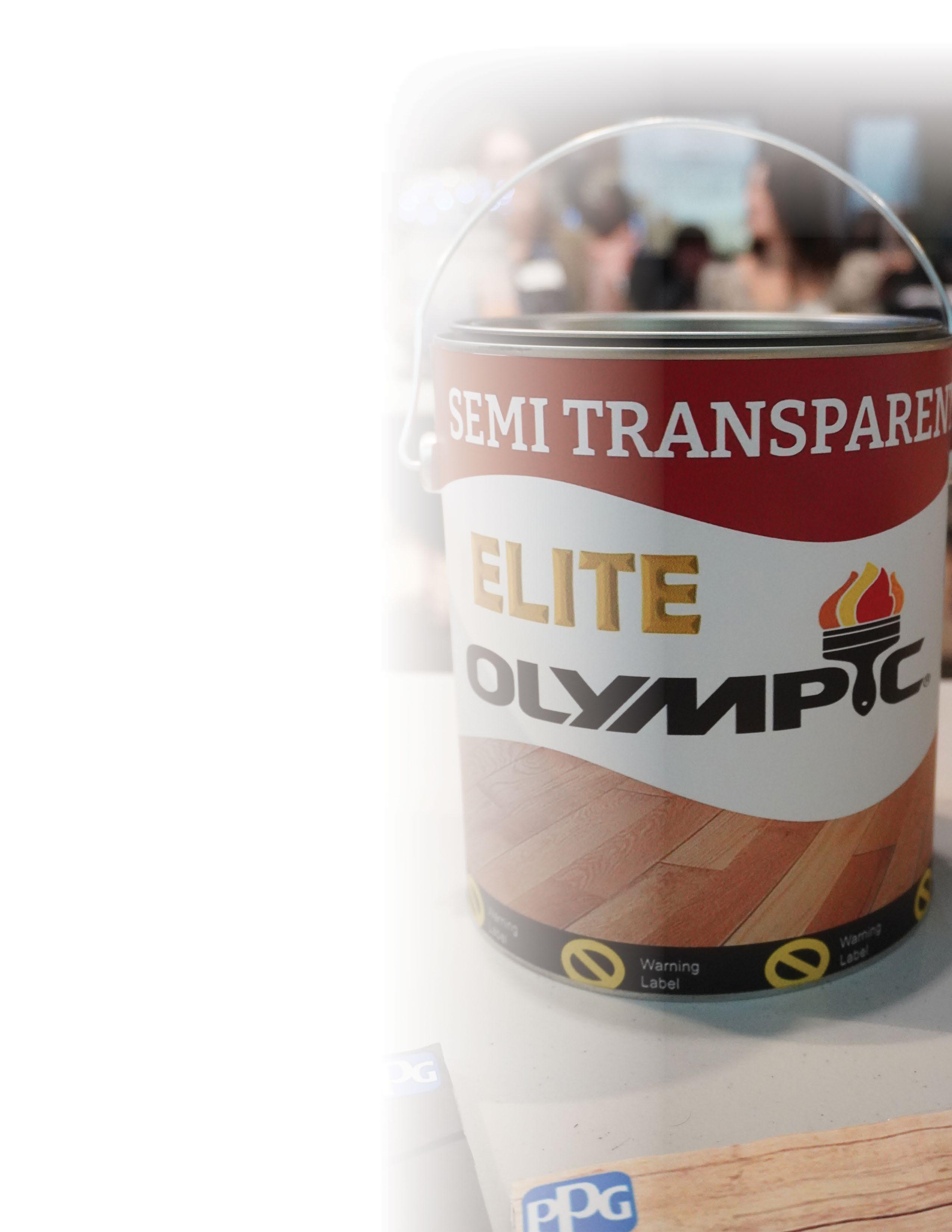
• Designing and prototyping an automated box folding workcell
• Developing a proof of concept and determining the cost effectiveness of an AI-based pan inspection system
That partnership with All-Clad, initially part of an after-school activity until 2013, served as the foundation for expanded collaborations with additional local and national companies.

For the Allegheny County Sanitary Authority, exploratory science students determined the best way to communicate to residents the need to develop ways to reduce storm water overflows.
For Calgon Carbon, South Fayette students created a consumer market for odor-control products using the company’s granulated activated carbon.
For EAFab, students constructed a functioning model of an overhead crane to carry scrap materials to an electric arc furnace.
For Covestro, a supplier of high-performance plastics, South Fayette students tracked the flow of electronic waste and plastic materials after consumers purchased them. They also determined the business opportunities for the company that could result from the construction of solar and wind energy generation.
For Hennecke, South Fayette students created safer and more cost-effective drone methods instead of sending inspectors onto chemical containers.
Just this school year, graphic design students created new marketing brochures and in-store displays for PPG. Marketing representatives from the Pittsburgh-based company remarked that they did not get this type of experience until college. And even then, it was not at the level of South Fayette’s program.
Isaac says the most rewarding part of problembased learning comes when their industry partners implement the solutions his students propose.
“All-Clad’s website looks the way it does today because of South Fayette students,” Isaac explained. “EAFab uses the formula students developed to measure the radius of curvature for metal pipe based on a pipe rolling machine’s settings. Hennecke’s lobby space in its new headquarters was designed by our students. PPG designers took our students’ work straight to a design meeting that afternoon.”
High school student presents solutions to All-Clad leadership in 2016. High school consultants debrief with leaders from Calgon Carbon. This paint can design was created by South Fayette students and presented to PPG graphic designers.High school STEAM Coordinator Jim Hausman said South Fayette’s problem-based learning program allows students to drive the process.
“Engaged, passionate learning does not look like traditional learning,” said Hausman. “We learn by doing. And these projects facilitate learning for organic growth.”
Hausman’s students are most impacted by how they are treated by the industry professionals.

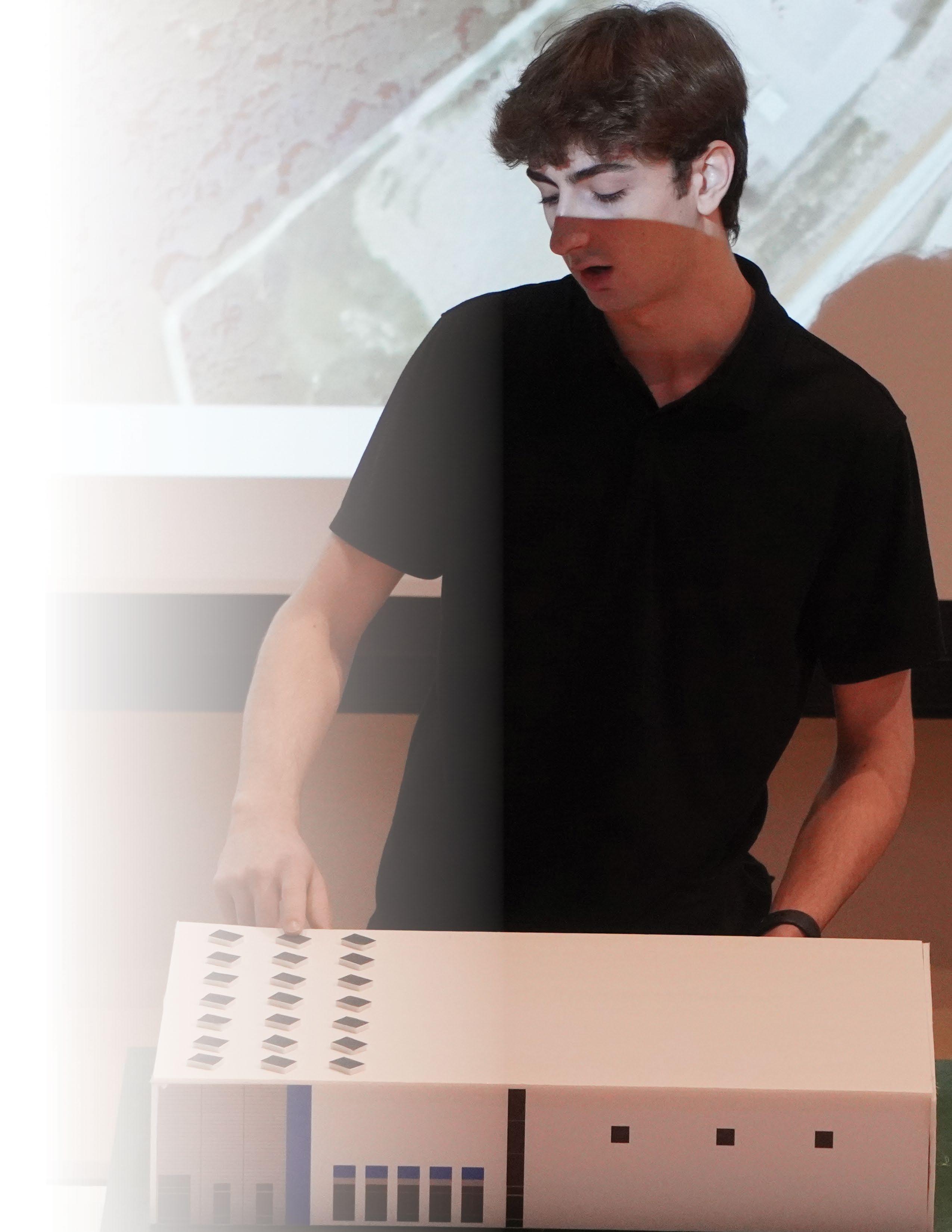
“The typical roles melt away, and that changes everything for our students,” Hausman described. “These experts with decades of experience speak with the students as peers. And our students are always amazed when they are taken seriously and treated as adults.”
In fact, All-Clad representatives do not call them “students.” Rather, they’re called “consultants.”
Problem-based learning alongside leading national companies gives South Fayette students a glimpse into their futures, Isaac said.
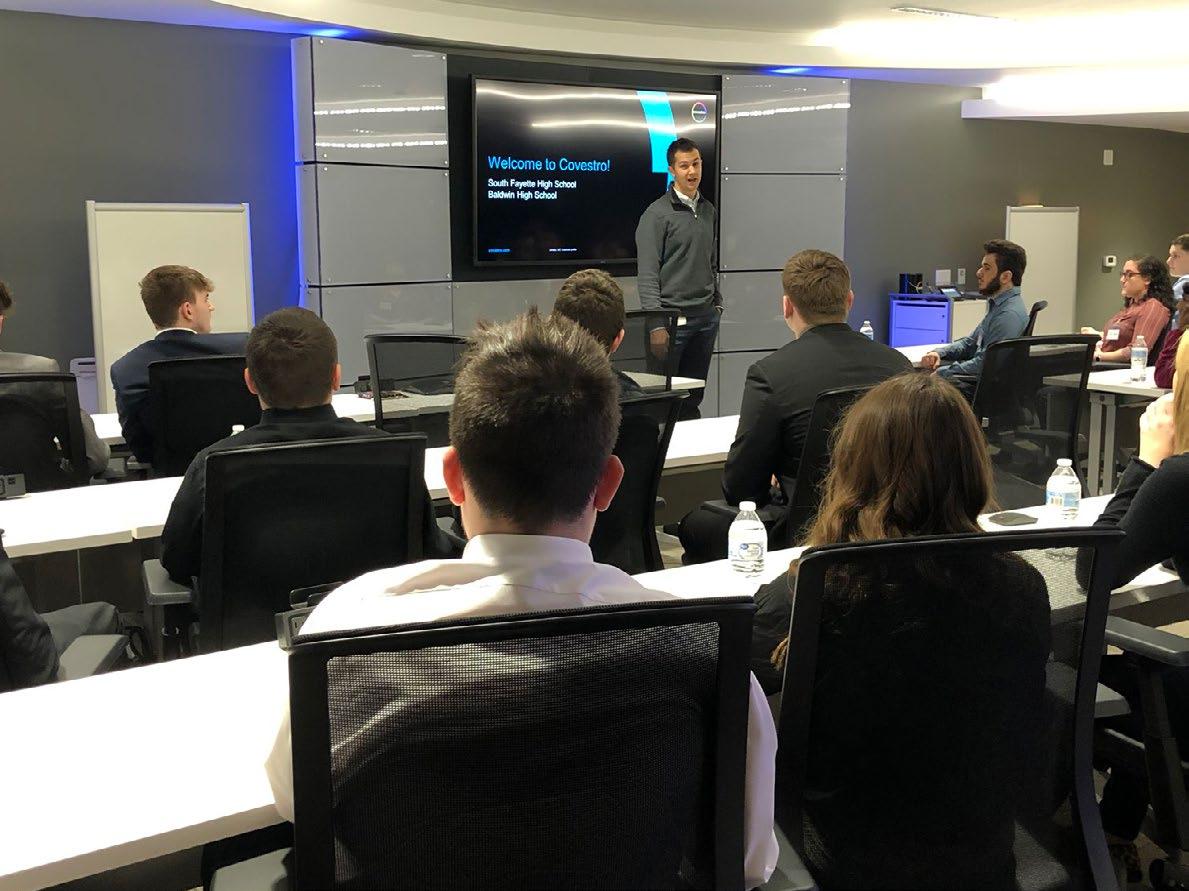
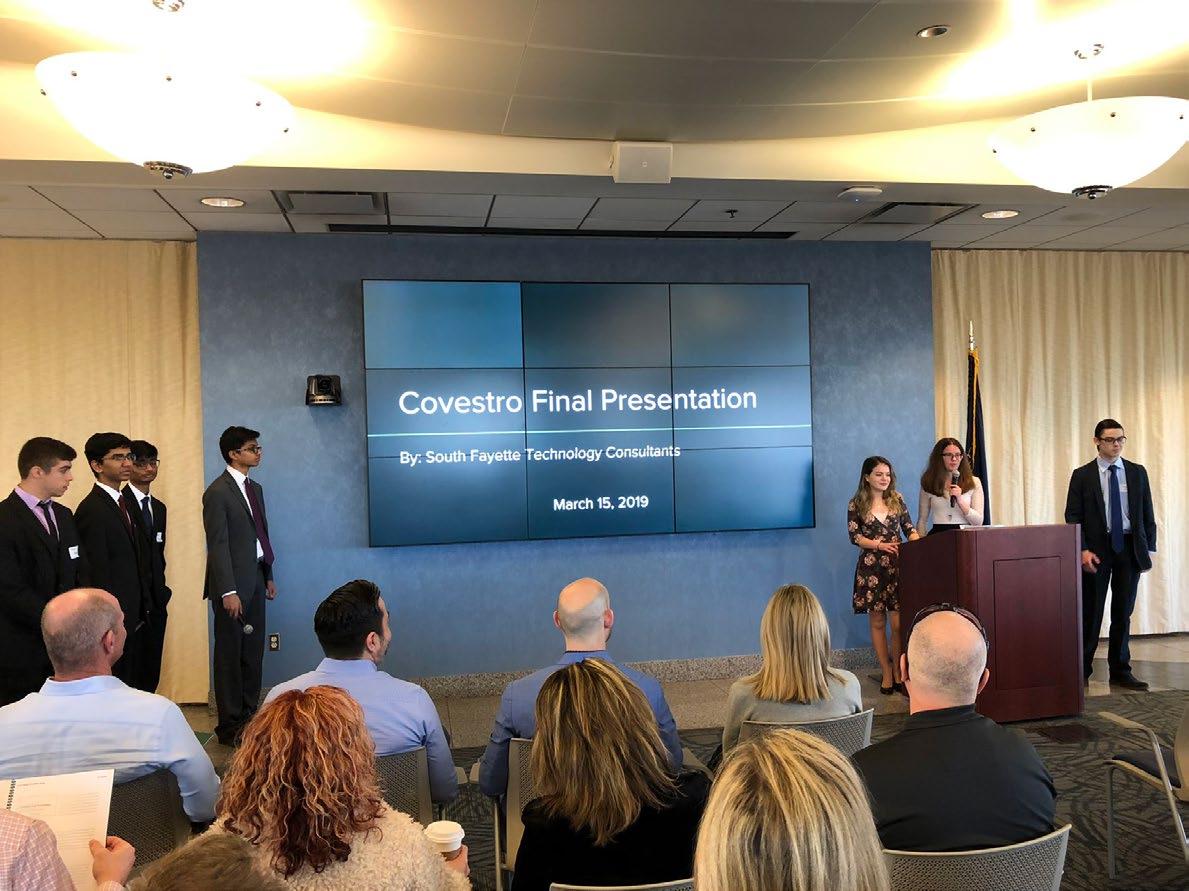
“We have kids who after graduating college come back to tell us that the work they did in South Fayette classrooms was more challenging, enriching, and beneficial than any project they did in college,” he said. “These opportunities give them the space to come and grow and may land them internships and careers.”
For Hausman, South Fayette’s focus on problem based learning is invigorating.
“I’m excited to be a teacher again,” Hausman said.
High school senior proposes his solution to place solar panels on the roof of Hennecke’s headquarters. Leaders from All-Clad test box folding device created by South Fayette consultants. High school consultants present their final project to leaders from Covestro. South Fayette students meet with representatives from Covestro.PBL PARTNERSHIPS WITH UNIVERSITIES
When leading faculty from one of the world’s first and finest computer science programs at Carnegie Mellon University in Pittsburgh, Pennsylvania recognized the real need for a rigorous and relevant high school computer science curriculum, they turned to the educators and students of South Fayette High School. Now, six years since that initial partnership, South Fayette’s leading role in this initiative aimed at inclusivity has helped to impact a quarter million students in schools worldwide.
Carnegie Mellon University professors David Kosbie and Mark Stehlik noticed a disconnect between what was being taught in high school computer science classrooms from what was being taught in college and university classrooms. Kosbie and Stehlik teach a nationally recognized introductory programming course at Carnegie Mellon and always desired to get that course into high schools.
“The problem with that vision was that it was a CMU introductory course for CMU students,” Stehlik explained. “There are not that many CMU-caliber students in the world. So if your goal is to get to that population, you cannot start at the end. You had to start at the beginning.”
That realization was confirmed when Kosbie spoke with a group of computer science teachers from high schools across western Pennsylvania in 2017. Those teachers told Kosbie that they are not the computer science professionals and requested that the world-renowned professionals at Carnegie Mellon develop a meaningful, impactful high school curriculum.
Just one year after that meeting with computer science teachers across the region, Kosbie and Stehlik were ready to launch a pilot of their flagship course in the newly created CMU Computer Science Academy. This CS1 curriculum would explore the fundamentals of programming concepts, teaching text-based coding using Python. And when looking for school districts with which to partner, Kosbie and Stehlik immediately knew South Fayette needed to be included. They had already learned how South Fayette was a leading force in creating not just 9-12 computer science pathways, but K-12 computer science pathways.
“[South Fayette] was not just one of the first western Pennsylvania schools, but Pennsylvania schools to not only recognize the importance of computer science, but multiple CS pathways, starting early and branching out as you move through K-12 space,” Stehlik said.

South Fayette was one of only 14 school districts to partner with Carnegie Mellon for the pilot of the Python course in 2018. Eleven of educator Dawn McCullough’s high school students enrolled in that pilot course and were key in its development.
“Everything you can imagine happened in that course,” McCullough described. “These students were helping to design curriculum as they went through the course. They experienced firsthand what worked and what did not work in a high school setting.”
The CS1 curriculum that South Fayette educators and students helped to expand requires no programming experience. It is predicated on the belief that learning about programming and computer science should be fun and engaging for learners of all backgrounds. It builds “an inclusive and diverse computing culture” that “involves understanding the personal, ethical, social, economic, and cultural contexts in which people operate.” The course fosters the inclusion Kosbie and Stehlik desired by considering the needs of diverse users and producing inclusive computational products.
That pilot served as the foundation for the partnership between South Fayette and Carnegie Mellon. Since then, South Fayette High School educators and students have piloted Carnegie Mellon’s CS0 class in eighth grade, as well as upper level high school courses. Just nine other schools have been a collaborator with Carnegie Mellon since the beginning.
“There is such an appetite for computer science in South Fayette, and it starts with the pathways before a student ever enters high school,” McCullough said. “The district gave me all the time I needed to spend with the CMU professionals and the resources I needed to be the best in the classroom. And Carnegie Mellon reciprocated with all of their knowledge and resources. They are changing the world. It truly is the perfect working partnership.”
“South Fayette helped us do proof of concept,” said Stehlik. “South Fayette helped us smooth out the rough edges and iron out the wrinkles. That was the purpose of it. We knew we could create something useful. The question was – could we create something useful to a wide swath of teachers with a wide swath of experience.”
Taking what they learned from the pilot with South Fayette, Carnegie Mellon made the program online and graphics-based, requiring minimal installation and making it free for any school that wants it. They prioritized ongoing professional development with teachers, leading to a 24/7 chat feature provided by CMU student-teams.
“A lot of the lessons we learned in those early days were instrumental in the CS Academy now having the success it does, not only in the United States but across the globe,” Stehlik said.
The Carnegie Mellon University Computer Science Academy has now served more than 250,000 students worldwide. Half of those schools are Title I schools, speaking to the power of the free, online, equitable, and accessible program – a program that had its beginnings in a South Fayette High School classroom.
“[South Fayette] was not just one of the first western Pennsylvania schools, but Pennsylvania schools to not only recognize the importance of computer science, but multiple CS pathways, starting early and branching out as you move through K-12 space.”
Mark Stehlik CMU Professor
PBL FOR SOCIAL GOOD
When problem solving with a social focus is at the core of a school’s learning environment, its students will proactively seek out opportunities to improve the lives of others.

This school year, South Fayette High School seniors Shreya Rathi and Sejal Verma quickly gained national attention for their startup company, Maytik. They were interviewed by Forbes Magazine in an article on how teenage entrepreneurs think businesses will transform with the advent of ChatGPT. In March, they presented their first product to entrepreneurs and investors at South by Southwest in Austin, Texas. Their success story is one of innovation, drive, and determination. But most of all, it is one of inclusivity.
Shreya and Sejal applaud the substantial steps towards inclusivity taken by the beauty industry. But they noticed those companies rarely feature accessible makeup lines and products for individuals with blindness or low vision. They said the only step a handful of companies took was including braille on their packaging.
Even that, they explain, is an ineffective method to promote inclusivity since not all individuals with blindness or low vision read braille.
“Palettes are even more confusing because a person will not be able to tell if they are using the color red or gold,” said Sejal. “They need a universal method, other than braille, to differentiate color.”
With that thought serving as their motivation, Shreya and Sejal began their work last school year as part of the Girls’ STEAM afterschool program to develop the first tech-integrated makeup palette. They met with electrical engineers and business managers to build a palette and a business. But it was their collaboration with Chloe and Darlene, two students at the Western Pennsylvania School for Blind Children, that gave them the insight they needed to take Maytik to the next level.
From Chloe and Darlene, the South Fayette seniors learned that haptics such as vibrations are ideal ways to communicate with the user. Shreya and Sejal decided to use haptic technology to signal the colors on the palette.
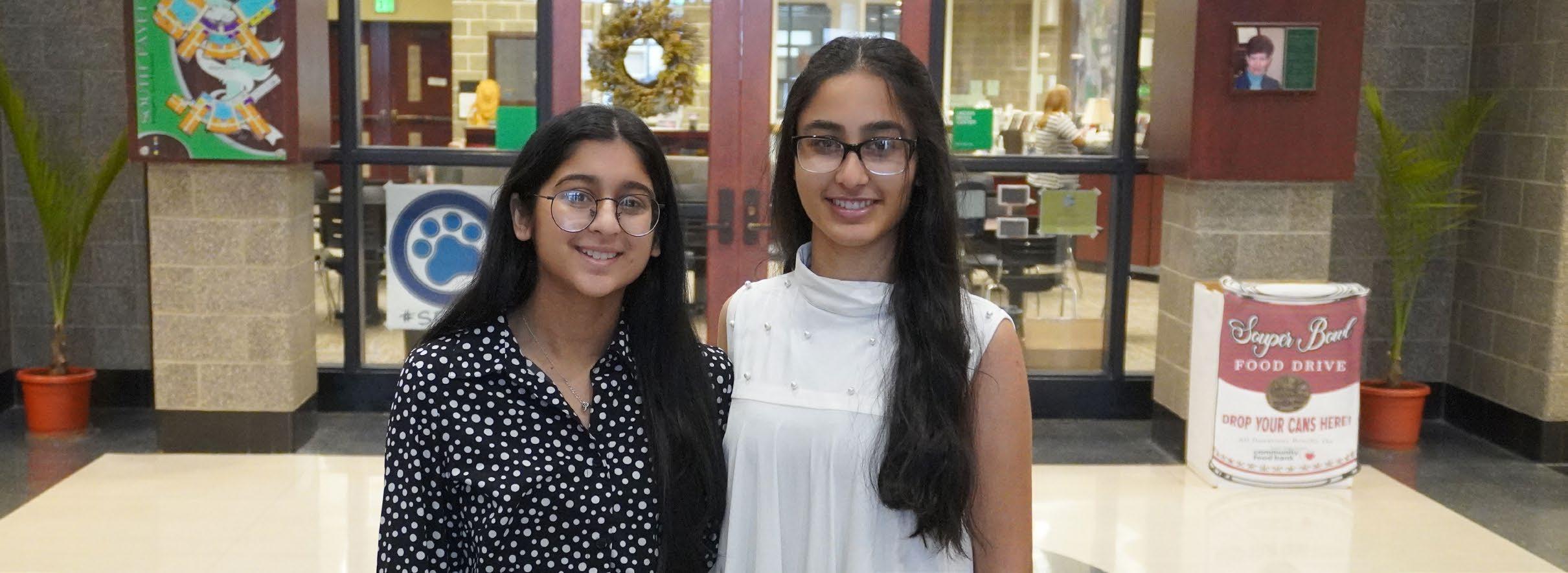
The palette works somewhat like a keyboard. As a user presses a shade, a signal is sent to the speaker, announcing the shade’s name. As users go down the palette and the color of the shade intensifies, so too does the intensity of the vibrations from the palette. All of it is made possible by the designs and circuits built by Shreya and Sejal.
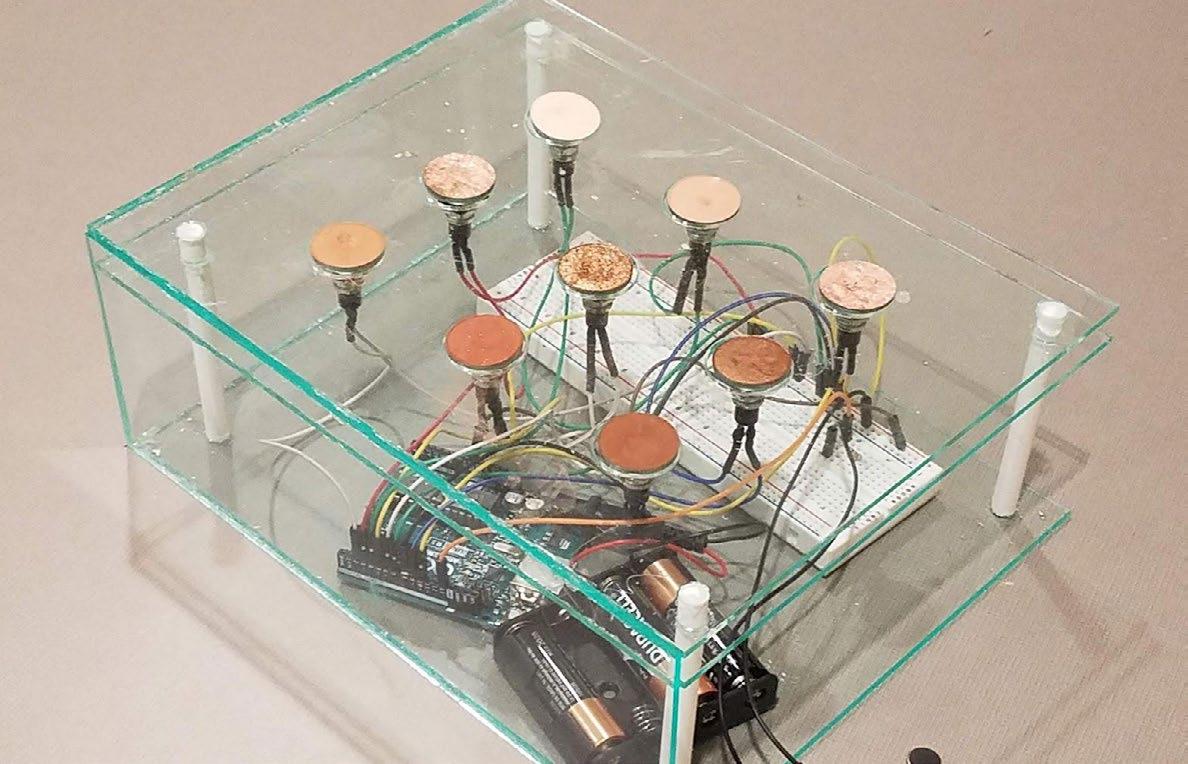
After developing the palette, Shreya and Sejal took it to their community partners Chloe and Darlene. Their reaction was something Shreya and Sejal say they will never forget.
“Their faces beaming with excitement and eagerness illustrate the powerful change our product can create in many lives,” Shreya said.
That powerful change has been noticed both regionally and nationally. Shreya and Sejal first participated in Project Invent and won the Explorer Award at Demo Day East. Most recently, they took first place in the TRETC (Three Rivers Educational Technology Conference) Student Pitch Competition. They were global finalists for the South by Southwest EDU Student Startup Competition, and they showcased their product in front of and receive coaching and feedback from successful entrepreneurs.
The seniors say this experience has taught them valuable technical and soft skills by running all aspects of the start-up.
“One day I’m designing the logo, presentation, and business cards, but the next day I’m calculating the financial projections and writing a business executive summary,” said Sejal.
Their work, however, revolves around the reason they first were interested in STEM – impact.
“When you begin to design and create a product for someone with an experience you have never shared, it is imperative that one must listen and think of others’ needs as if they were their own,” Shreya explained.
“It’s astounding how much a simple product I created can brighten someone’s life,” said Sejal. “The smiles on their faces and joyful laughter as they used the palette are something I will never forget. Being the reason for someone’s happiness is gratifying, but being the reason they can experience something they have never been able to is a celebratory cause. For me, there is no bigger joy than making someone smile and feel confident.”
“Partnerships such as this one, initiated by student-entrepreneurs seeking to enhance the lives of others, are powerful,” said Dr. Heidi Ondek, executive director and superintendent of the Western Pennsylvania School for Blind Children. “I am proud of the students of South Fayette High School and Western Pennsylvania School for Blind Children for their collaboration and creative work in service to others.”
Students Shreya Rathi and Sejal Verma Students’ tech-integrated make-up paletteThe problem presented to students sometimes is one they cannot directly solve on their own. While this could lead to frustration, disengagement, and resignation in traditional educational settings, in South Fayette schools where collaboration and philanthropy are incorporated into problem-based learning, students, and in turn an entire community, quickly appreciate the value of their role in a mission much bigger than themselves.
Approximately 16,000 children in the United States will be diagnosed with cancer this year, and more children die from cancer than any other disease. Thanks to research and treatment advancement, more than 85% of children with cancer will now survive five years or more. Some of that groundbreaking research happens four hours from South Fayette. While 220 miles may separate South Fayette High School and Penn State Children’s Hospital, they are forever connected through the work to conquer childhood cancer.
Since 2013, South Fayette High School has partnered with Four Diamonds, an organization dedicated to the fight against pediatric cancer at Penn State Children’s Hospital, through its Mini-THON program. Four Diamonds’ work focuses on three main areas: compassionate care, comprehensive support, and innovative research.

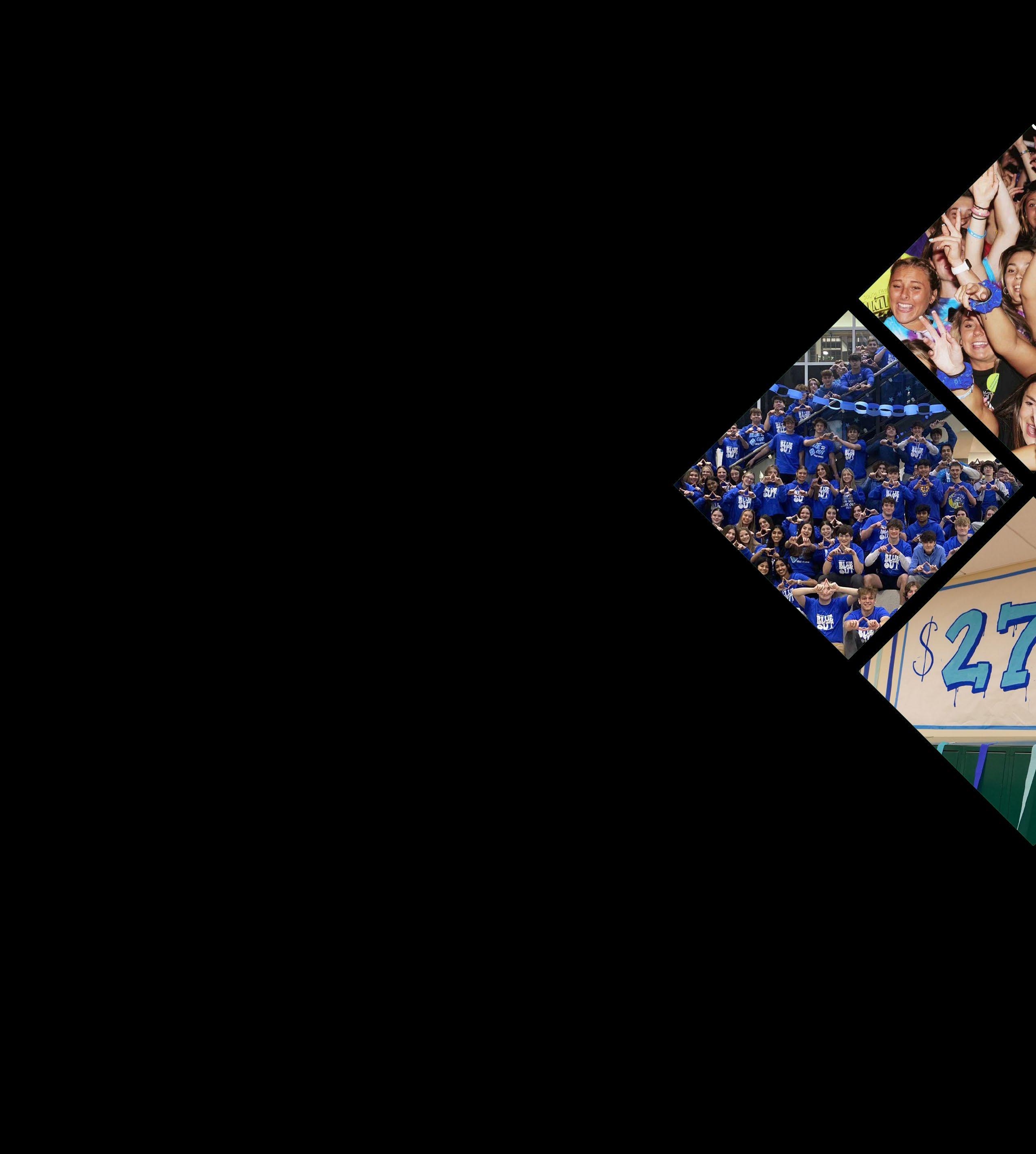
“When your child is diagnosed with cancer, first you feel the weight of that diagnosis,” said Tina Shearer, associate director of MiniTHON with Four Diamonds. “But then very quickly, you might be concerned with how you’re going to pay for this. Battling cancer is expensive. That’s a critical part of Four Diamonds, and why I think so many students throughout our program really enjoy raising funds. Because then all that family has to worry about is getting that child healthy.”
Modeled after the annual 46-hour dance marathon, THON, at Penn State University, Mini-THON empowers K-12 students to serve as leaders in the fight against childhood cancer. Students who volunteer as part of their school’s Mini-THON program fundraise throughout the year for Four Diamonds and cap off their efforts with a grand celebration. When South Fayette High School first hosted Mini-THON in 2013, it was structured much like the Mini-THONs at the more than 200 schools that currently partner with Four Diamonds. Organized by the Student Government at South Fayette High School that first year, students raised a little more than $3,000. Soon, a change would revolutionize this fundraising effort, bringing it into the high school’s curriculum and, according to Shearer, making South Fayette’s Mini-THON a “best-in-class program.”

After that first year – and a Mini-THON that cost Student Government more than it raised – high school faculty looked at how to embed educational and problem-based learning opportunities into it to make the program viable. Their solution was to develop an honors course within the school’s business department where students would employ the marketing and event planning skills they learned and oversee the school’s Mini-THON donor drive and dance marathon. Fourteen students enrolled in the first honors management and marketing applications class with high school educator Brandon Flannery. The seniors raised more than $8,000 in sponsorships and raised more than $21,000 for Four Diamonds.
As Flannery developed the course, working closely with Point Park University’s Rowland School of Business, the enrollment, student interest, and money raised steadily increased. The course soon would reach its 32-student maximum every year. Flannery says the seniors who register for the class must be prepared to invest plenty of time and energy over their final semester of high school. Students rely on their critical understanding of event management, promotion, ticketing, corporate sponsorship, and fundraising to plan, manage, and market Mini-THON.
SOUTH FAYETTE MINI-THON’S IMPACT THROUGH THE YEARS
While Flannery is the teacher and sponsor of Mini-THON, he admits he takes a hands-off approach, which enables his students who work in one of four groups to be involved in every single aspect of the event. From recruiting participants, developing sponsorship packages, soliciting donations, managing social media, to planning a 12-hour event, honors management and marketing applications students do it all. And if they briefly go off track, Flannery steps in.
“All I have to do is remind them of their center,” Flannery said. “We’re here for the kids.”
This approach is what Shearer says sets South Fayette apart. While most Mini-THON events across the state and country are an extracurricular activity, South Fayette’s is an integral part of the school’s curriculum. She says only a few other schools have attempted to “dabble” in making Mini-THON part of the curriculum, but none have been as successful as South Fayette. And the numbers prove it.
In spring 2022, South Fayette’s Mini-THON celebrated reaching the $1 million mark over its ten-year history. According to Shearer, Four Diamonds Mini-THONs have raised nearly $55 million since 1994. That means approximately 2% of the all the money raised from Mini-THONs across the country over nearly three decades has come from South Fayette High School in ten years. Last year, more than 600 South Fayette students raised a record $258,000. This year, 800 students, nearly three quarters of the high school student body, are registered to participate in the twelve-hour event. Their goal would set another record, $275,000.
It’s an amount of money that Dean of the Rowland School of Business at Point Park University Stephen Tanzilli says some professionals do not raise in their entire careers. South Fayette High School has a partnership with Point Park University, and students enrolled in the honors management and marketing applications course can earn college credit at Point Park University.
Tanzilli, a South Fayette resident, says the MiniTHON is so successful because it is competitive, but collegial. Students have the drive to top the previous year’s total, but recognize the purpose behind their work. He knows the experience gained in Flannery’s class does not just benefit students when applying to colleges. Tanzilli says South Fayette students can, and should, highlight their achievements with Mini-THON in job interviews after graduating college.
“I think what’s successful at South Fayette is because there is that focus on [Mini-THON], and it has become a culture,” Shearer said. “Community involvement is probably one of the biggest success factors, and one of those that other schools look to South Fayette to do.”
Shearer appreciates that Flannery has embraced a quasi-ambassador role for Four Diamonds. When new schools join Four Diamonds, Flannery is the first to speak with and offer advice to the new advisors. Shearer said Flannery is always willing to share what makes South Fayette’s program so successful, with the hope that students across the country can experience the academic and personal benefits his students do every year.
“Mini-THON gathers amazing people,” Shearer said. “It takes a special type of person to give so much of themselves towards a cause larger than themselves. It takes the best students, the best faculty, the best administration. That’s why South Fayette stands out.”
$258,365
THE IMPACT OF PBL
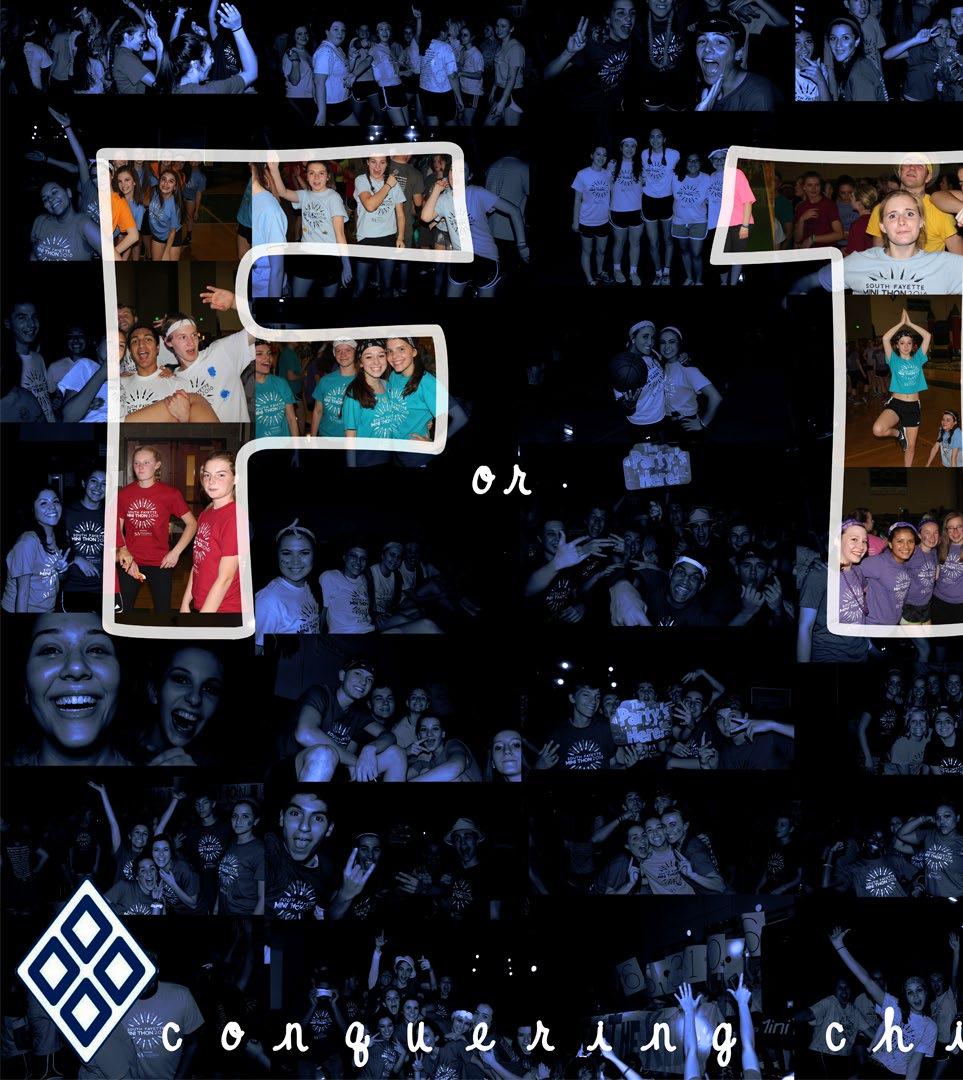


 In the video above, South Fayette alum Joey Giaquinto (‘19) speaks about the personal and professional impact of Mini-THON. Associate Director of Mini-THON with Four Diamonds Tina Shearer speaks about how South Fayette’s Mini-THON is used as a model throughout the country.
In the video above, South Fayette alum Joey Giaquinto (‘19) speaks about the personal and professional impact of Mini-THON. Associate Director of Mini-THON with Four Diamonds Tina Shearer speaks about how South Fayette’s Mini-THON is used as a model throughout the country.
SOUTH FAYETTE TOWNSHIP SCHOOL DISTRICT
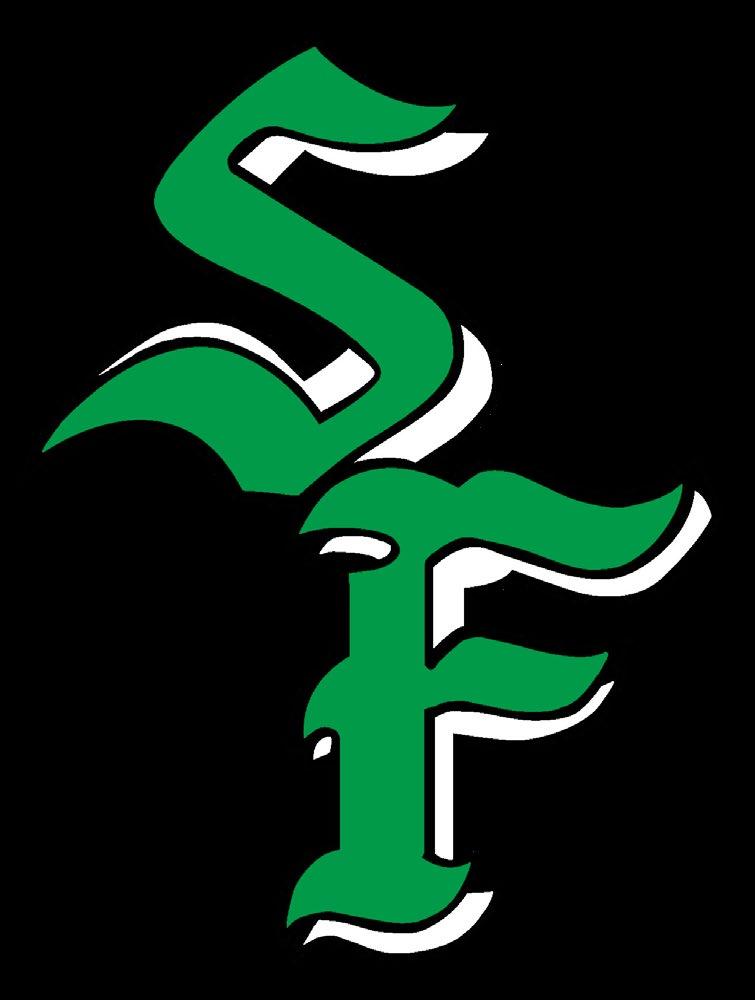
FUTURE-FOCUSED. STUDENT-CENTERED. INNOVATION-DRIVEN

